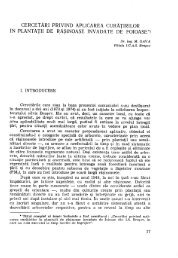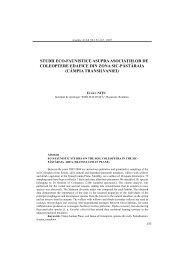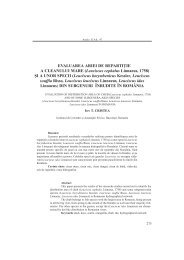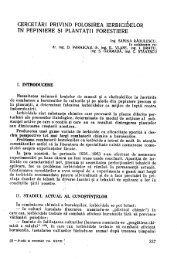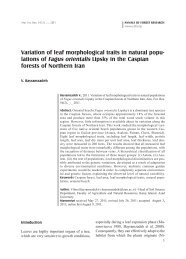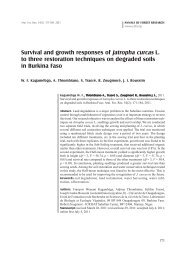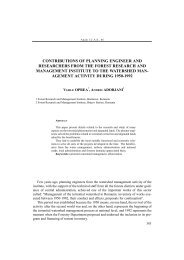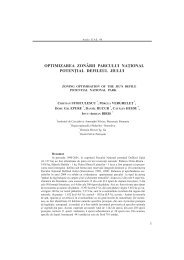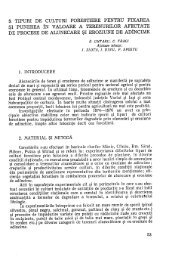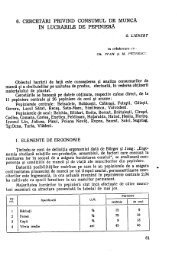Romania (Quercus cerris, Q. frainetto, Q. robur) and - EdituraSilvica.ro
Romania (Quercus cerris, Q. frainetto, Q. robur) and - EdituraSilvica.ro
Romania (Quercus cerris, Q. frainetto, Q. robur) and - EdituraSilvica.ro
Create successful ePaper yourself
Turn your PDF publications into a flip-book with our unique Google optimized e-Paper software.
Ann. For. Res. 54(1): 57-71, 2011Research articlesLocations <st<strong>ro</strong>ng>and</st<strong>ro</strong>ng> <st<strong>ro</strong>ng>Quercus</st<strong>ro</strong>ng> speciesDistanceFigure 3 Cluster Analysis of mycorrhizal morphotypes associated with <st<strong>ro</strong>ng>Quercus</st<strong>ro</strong>ng> <st<strong>ro</strong>ng>cerris</st<strong>ro</strong>ng>, Q. <st<strong>ro</strong>ng>frainetto</st<strong>ro</strong>ng> <st<strong>ro</strong>ng>and</st<strong>ro</strong>ng> Q.<st<strong>ro</strong>ng><strong>ro</strong>bur</st<strong>ro</strong>ng> using Sørensen Similarity Index <st<strong>ro</strong>ng>and</st<strong>ro</strong>ng> Average Linkage Method.Notation: 1 - <st<strong>ro</strong>ng>Quercus</st<strong>ro</strong>ng> <st<strong>ro</strong>ng><strong>ro</strong>bur</st<strong>ro</strong>ng>, Buteni; 2 - <st<strong>ro</strong>ng>Quercus</st<strong>ro</strong>ng> <st<strong>ro</strong>ng><strong>ro</strong>bur</st<strong>ro</strong>ng>, Oradea; 3 - <st<strong>ro</strong>ng>Quercus</st<strong>ro</strong>ng> <st<strong>ro</strong>ng>cerris</st<strong>ro</strong>ng>, Brneti; 4 - <st<strong>ro</strong>ng>Quercus</st<strong>ro</strong>ng><st<strong>ro</strong>ng>frainetto</st<strong>ro</strong>ng>, Mihai Bravu; 5 - <st<strong>ro</strong>ng>Quercus</st<strong>ro</strong>ng> <st<strong>ro</strong>ng>cerris</st<strong>ro</strong>ng>, Mihai Bravu; 6 - <st<strong>ro</strong>ng>Quercus</st<strong>ro</strong>ng> <st<strong>ro</strong>ng>frainetto</st<strong>ro</strong>ng>, Dobreti; 7 - <st<strong>ro</strong>ng>Quercus</st<strong>ro</strong>ng> <st<strong>ro</strong>ng>cerris</st<strong>ro</strong>ng>,Dobreti; 8 - <st<strong>ro</strong>ng>Quercus</st<strong>ro</strong>ng> <st<strong>ro</strong>ng>cerris</st<strong>ro</strong>ng>, Tinca; 9 - <st<strong>ro</strong>ng>Quercus</st<strong>ro</strong>ng> <st<strong>ro</strong>ng>frainetto</st<strong>ro</strong>ng>, Tinca; 10 - <st<strong>ro</strong>ng>Quercus</st<strong>ro</strong>ng> <st<strong>ro</strong>ng>cerris</st<strong>ro</strong>ng>, Oradea; 11 - <st<strong>ro</strong>ng>Quercus</st<strong>ro</strong>ng><st<strong>ro</strong>ng>cerris</st<strong>ro</strong>ng>, Arad; 12 - <st<strong>ro</strong>ng>Quercus</st<strong>ro</strong>ng> <st<strong>ro</strong>ng>frainetto</st<strong>ro</strong>ng>, Arad (Radna); 13 - <st<strong>ro</strong>ng>Quercus</st<strong>ro</strong>ng> <st<strong>ro</strong>ng>cerris</st<strong>ro</strong>ng>, tefneti; 14 - <st<strong>ro</strong>ng>Quercus</st<strong>ro</strong>ng> <st<strong>ro</strong>ng>cerris</st<strong>ro</strong>ng>,Vlsia; 15 - <st<strong>ro</strong>ng>Quercus</st<strong>ro</strong>ng> <st<strong>ro</strong>ng>cerris</st<strong>ro</strong>ng>, Slveti; 16 - <st<strong>ro</strong>ng>Quercus</st<strong>ro</strong>ng> <st<strong>ro</strong>ng>frainetto</st<strong>ro</strong>ng>, Slveti; 17 - <st<strong>ro</strong>ng>Quercus</st<strong>ro</strong>ng> <st<strong>ro</strong>ng>cerris</st<strong>ro</strong>ng>, Vldiceasca; 18- <st<strong>ro</strong>ng>Quercus</st<strong>ro</strong>ng> <st<strong>ro</strong>ng>cerris</st<strong>ro</strong>ng>, Bneasa; 19 - <st<strong>ro</strong>ng>Quercus</st<strong>ro</strong>ng> <st<strong>ro</strong>ng>frainetto</st<strong>ro</strong>ng>, Comana (Giurgiu); 20 - <st<strong>ro</strong>ng>Quercus</st<strong>ro</strong>ng> <st<strong>ro</strong>ng>cerris</st<strong>ro</strong>ng>, Brgan.mycelia <st<strong>ro</strong>ng>and</st<strong>ro</strong>ng> assimilative <strong>ro</strong>ots associated inmycorrhizae operates in allocations <st<strong>ro</strong>ng>and</st<strong>ro</strong>ng> reallocationsof nutrients, water, in blocking thepotential <strong>ro</strong>ot infection courts relying on thediversity of mycobionts, each performing adifferent job. The identied 30 morphotypes,associated with species of <st<strong>ro</strong>ng>Quercus</st<strong>ro</strong>ng>, are assigneddifferently, depending on geographicaldistribution of hosts, on health status (there arefewer <strong>ro</strong>ot active apices in trees vegetating understressful conditions) <st<strong>ro</strong>ng>and</st<strong>ro</strong>ng> host species.The niche partitioning among several mycobiontsis possible because the ectomycorrhizalfungi differ in their tolerance to water stress<st<strong>ro</strong>ng>and</st<strong>ro</strong>ng> temperature extremes, in their ability totake up different nutrients, their resistance topathogens (Jones et al. 1998). The instantaneousrichness value, for morphotypes active ata certain moment on the same host species isfar less than the total richness of the existingmycobionts, associated with a host, as can berevealed by molecular methods. During the investigationsof the present study, the maximum68number of active morphotypes associated to ahost species, in a particular location, was of 14(<st<strong>ro</strong>ng>Quercus</st<strong>ro</strong>ng> <st<strong>ro</strong>ng>cerris</st<strong>ro</strong>ng> at Dobreti), a fact that is concordantwith the hypothesis of redundant speciesas functional insurance (Yachi & Loreau,1999). There is a sequential mobilization ofmycorrhizal fungi f<strong>ro</strong>m the common speciespool, active within a particular time window.The degree of mycorrhization differs amongtrees, parts of the <strong>ro</strong>ot system, <st<strong>ro</strong>ng>and</st<strong>ro</strong>ng> phenologically.Our ndings revealed a uctuation infrequencies of mycorrhizal apices between13.1% <st<strong>ro</strong>ng>and</st<strong>ro</strong>ng> 86% during the same period.One of our ndings during the study is thedominance of C. geophilum morphotype, aresult shared with other similar studies. Gerhardtet al. (2007) found that this is the dominatingmorphotype in 80% of the investigated<st<strong>ro</strong>ng>Quercus</st<strong>ro</strong>ng> rubra st<st<strong>ro</strong>ng>and</st<strong>ro</strong>ng>s also the most abundantmycorrhiza forming mycobiont on the <strong>ro</strong>otsof <st<strong>ro</strong>ng>Quercus</st<strong>ro</strong>ng> garryana (Valentine et al. 2004).C. geophilum is a pioneer stage mycorrhizalpartner but, also a late stage, being present



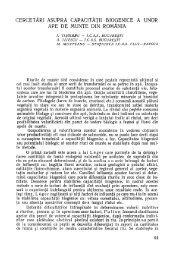
![studiu privind conditiilb] de vegetatie ale ... - EdituraSilvica.ro](https://img.yumpu.com/50877313/1/175x260/studiu-privind-conditiilb-de-vegetatie-ale-editurasilvicaro.jpg?quality=85)

